Primary bone cancer, although rare, represents a major public health issue, affecting around 1,000 people each year in France, 70% of whom are under 18. Rapid diagnosis and the implementation of appropriate treatment are essential to improve the chances of recovery.

- Primary bone cancer presents with bone and joint symptoms, fractures, difficulty moving, and sometimes a palpable mass.
- More general signs such as fatigue, sweating, fever and weight loss may also be present.
- Consulting a doctor as soon as several of these symptoms appear is essential for early diagnosis and treatment.
Primary bone cancer, although rare, can affect all ages, with a higher prevalence in children and adolescents. Although the symptoms may be subtle at first, it is crucial to be aware of them in order to seek medical attention quickly and begin appropriate treatment.
Symptoms of bone cancer may be mild or nonspecific, appearing gradually as the tumor grows.
Eight warning signs you shouldn’t ignore:
1. Bone or joint pain
• Persistent pain, especially at night or during exercise
• Progressive worsening
• Precise location on a bone or joint
2. Swelling or palpable mass on a bone
• Visible swelling or lump that can be felt when touched
• Progressive increase in volume
3. Difficulty moving or using a limb
• Joint stiffness
• Loss of strength or mobility
• Lameness
4. Bone fractures
• Frequent breakages, without significant trauma
• Weakening of bones due to the tumor
5. Intense fatigue
• Persistent exhaustion, without apparent cause
• Decreased energy and vitality
6. Excessive sweating
• Heavy night sweats
• Sweating without physical effort
7. Unexplained fever
• Febrile episodes without identifiable infection
• Increased body temperature without obvious cause
8. Unintentional weight loss
• Decreased appetite without changing diet
• Involuntary weight loss
If you experience several of these symptoms, it is crucial to consult a doctor without delay.
Screening and treatment: act early to cure
The diagnosis of bone cancer is based on a thorough clinical examination, medical imaging (X-ray, CT scan, MRI) and, in some cases, a biopsy.
Treatment depends on the type, stage, and location of the tumor. Surgery is often the mainstay of treatment, aimed at removing the tumor. Chemotherapy and radiation therapy may also be combined, before or after surgery, to destroy residual cancer cells and reduce the risk of recurrence.
The key message: Stay vigilant and consult if in doubtEarly diagnosis and prompt treatment significantly increase the chances of recovery and help maintain an optimal quality of life.

















